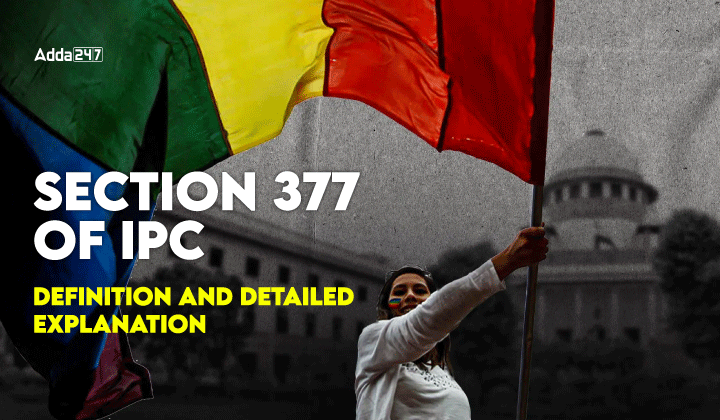Table of Contents
The decriminalization of consensual homosexuality by the Supreme Court of India in 2018 was a historic turning point in the Nation’s legal and human rights landscape. Section 377 of the Indian Penal Code (IPC), a colonial-era provision that criminalized “carnal intercourse against the order of nature,” was declared unconstitutional insofar as it applied to consensual sexual acts between adults. This monumental judgment not only marked a victory for the LGBTQ+ community but also reaffirmed the fundamental principles of equality, liberty, and dignity enshrined in the Constitution of India. In this article, we will delve into the definition, background, and significant impact of Section 377, while exploring the key legal arguments and constitutional challenges that shaped this landmark decision.
What is Section 377 of IPC?
Section 377 of the IPC was introduced in 1860 under British colonial rule. It criminalized any form of “carnal intercourse against the order of nature” with a man, woman, or animal, carrying a punishment of up to life imprisonment. While initially intended to penalize non-consensual and unnatural sexual acts, its vague wording led to the criminalization of consensual same-sex relations as well. This created a legal framework that discriminated against the LGBTQ+ community, subjecting them to persecution, harassment, and marginalization for over a century.
In 2018, the Supreme Court of India struck down the application of Section 377 to consensual homosexual acts between adults, while retaining its applicability in cases involving non-consensual sexual acts, bestiality, and sexual offenses against minors. This judgment effectively decriminalized homosexuality, ensuring that individuals could no longer be punished for their sexual orientation.
Section 377 Background
The origins of Section 377 can be traced back to British moral and legal codes that sought to regulate “deviant” sexual behavior. It was heavily influenced by Victorian-era Christian morality, which viewed any non-procreative sexual act as sinful. Despite India’s independence in 1947 and the adoption of a progressive Constitution in 1950, this archaic law remained on the statute books, perpetuating stigma and discrimination against sexual minorities.
For decades, LGBTQ+ individuals in India faced not only social ostracism but also the threat of legal action under Section 377. This law provided a tool for harassment by law enforcement agencies and made it difficult for individuals to openly express their sexual orientation without fear of punishment.
Timeline of the Debate on Section 377
The legal challenge to Section 377 began gaining momentum in the late 1990s and early 2000s, when several NGOs and activists sought to repeal the provision. The landmark moment came in 2001 when the Naz Foundation, an NGO working on HIV/AIDS prevention, filed a Public Interest Litigation (PIL) in the Delhi High Court, arguing that Section 377 impeded efforts to combat HIV/AIDS by driving the LGBTQ+ community underground.
- 2009: In a progressive judgment, the Delhi High Court declared Section 377 unconstitutional in Naz Foundation v. Government of NCT of Delhi, holding that it violated Articles 14, 15, and 21 of the Indian Constitution by discriminating against individuals based on their sexual orientation.
- 2013: However, this victory was short-lived, as the Supreme Court, in Suresh Kumar Koushal v. Naz Foundation, overturned the Delhi High Court’s decision. The Court argued that only Parliament could amend or repeal Section 377 and that the LGBTQ+ community constituted a “minuscule minority” whose rights were not at risk.
- 2017: A pivotal moment came with the Justice K.S. Puttaswamy v. Union of India judgment, where the Supreme Court recognized the right to privacy as a fundamental right under Article 21. This ruling indirectly bolstered the LGBTQ+ community’s argument, as the court held that personal choices, including sexual orientation, are integral to the right to privacy.
- 2018: Finally, in Navtej Singh Johar v. Union of India, a five-judge Constitution Bench of the Supreme Court unanimously struck down the portions of Section 377 that criminalized consensual homosexual acts between adults. The Court ruled that sexual orientation is an intrinsic part of one’s identity and that Section 377 violated the Constitutional principles of equality, dignity, and privacy.
Impact of Section 377 Decriminalization
The decriminalization of homosexuality had far-reaching social and legal consequences. It marked a critical step toward the recognition and acceptance of the LGBTQ+ community in India. The ruling significantly reduced police harassment and allowed individuals to live with dignity and freedom, free from the constant fear of legal persecution.
Moreover, the judgment has opened the door for further advocacy in areas such as same-sex marriage, adoption rights, inheritance rights, and anti-discrimination protections. It also fostered greater self-acceptance within the LGBTQ+ community, promoting mental and emotional well-being by affirming their identity and rights.
Arguments Against Repealing Section 377
Despite widespread support for the decriminalization of homosexuality, there were strong voices in opposition. Many religious groups and conservative factions argued that homosexuality was against societal and religious norms. They contended that the repeal of Section 377 would undermine traditional family values and morality, citing concerns about the “spread” of homosexuality and its potential public health risks, particularly in relation to HIV/AIDS.
However, these arguments were largely based on misinformation and prejudice. Modern medical and psychiatric studies have consistently shown that homosexuality is neither a disorder nor a public health hazard. The Supreme Court, in its 2018 judgment, dismissed these concerns, emphasizing that constitutional morality must take precedence over societal morality.
Constitutional Challenges under Section 377
The primary constitutional challenge to Section 377 revolved around its violation of fundamental rights guaranteed by the Indian Constitution. Petitioners argued that the law violated:
- Article 14: The right to equality before the law, as Section 377 discriminated against individuals based on their sexual orientation.
- Article 15: The prohibition of discrimination on the grounds of sex, which the court extended to include sexual orientation.
- Article 21: The right to life and personal liberty, including the right to privacy and dignity.
- Article 19: The right to freedom of expression, including the expression of one’s sexual identity.
In its final ruling, the Supreme Court upheld these arguments, declaring that the LGBTQ+ community is entitled to the same fundamental rights as all other citizens. The Court emphasized that personal sexual autonomy and identity are central to human dignity and must be protected under the Constitution.
Conclusion
The Supreme Court’s decriminalization of consensual homosexuality under Section 377 was a landmark victory for human rights in India. It affirmed the constitutional principles of equality, liberty, and dignity, while acknowledging that laws must evolve with changing societal norms and modern understandings of human identity. Although the journey toward full equality for the LGBTQ+ community is far from over, this judgment has laid a strong foundation for further legal and social advancements, ensuring that all citizens, regardless of sexual orientation, can live with dignity and freedom.



 TSPSC Group 1 Question Paper 2024, Downl...
TSPSC Group 1 Question Paper 2024, Downl...
 TSPSC Group 1 Answer key 2024 Out, Downl...
TSPSC Group 1 Answer key 2024 Out, Downl...
 UPSC Prelims 2024 Question Paper, Downlo...
UPSC Prelims 2024 Question Paper, Downlo...





